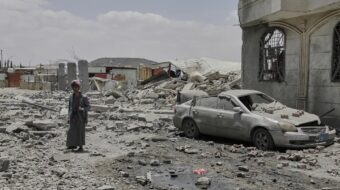News Analysis
The student movement in Iran is again at the forefront of the struggle against the ruling dictatorship. While focusing on George Bush’s so-called support for the protesters, conveniently absent from most media reports is the actual reason behind the students’ protests.
The first wave of demonstrations started on June 9 at Tehran University as part of an ongoing campaign opposing the privatization of universities. The regime has been zealously implementing the type of “economic restructuring” which would be admired by the Bush administration.
The protests were brutally attacked by security forces and vigilante groups organized by the regime. Mass arrests, vicious attacks with truncheons and machetes were commonplace. Assaults are not confined solely to the protests; frequently students’ dormitories are ransacked, and students are often abducted and brutalized.
As usual, the regime’s propaganda machine labeled the demonstrations as conspiracies of the U.S. and its agents, the “monarchists.” This is far from the truth. In fact the growing demonstrations are often spontaneous, with grassroots support.
The current protest has not sprung out of a vacuum or arisen because of sudden interest in Iran’s democratic process by the U.S. administration. During the last few years, a popular movement opposing the ruling Islamic government has spread across all sections of society. The vast majority of Iranians are highly contemptuous towards the religious medieval rulers and the popular movement for democracy and freedom has taken shape. A massive student demonstration in Tehran during July 1999, which was violently crushed, and numerous industrial strikes and demonstrations against rampant privatization didn’t capture the attention of the self-appointed “guardian of democracy” in the Middle East. In fact the aggressive presence of the U.S. military on our borders and the so-called support for freedom from the Bush administration would be highly detrimental to the struggle for democracy in our country.
During the Shah’s regime, the student movement in Iran struggled against that dictatorship while actively opposing the intrusive role of U.S. imperialism. In the current situation, as one of the students’ leaders stated, “The monarchists … are fighting for power, not democracy. And this will mean the loss of all intellectual efforts of the last hundred years for establishing a culture of democracy and forming a civic society in Iran.”
While starting on the basis of a student-related issue, the demonstrations spread quickly, gaining popular support and developing a political stance, which directly targeted the regime. This is indicative of the present critical situation, which has engulfed the regime’s power structure. Although the conservative rulers lack any legitimacy and support, the “Reform” process has also reached a deadlock. This is due to the disastrous policies pursued by the Reformist leadership, which in the eyes of the people has rendered them impotent. The Reformists have refused to integrate with the wider popular movement for democracy.
The Tudeh Party of Iran has consistently stated the need for the mobilization of key social forces, including workers, students and women, in the struggle for democracy. In supporting the student protests, the party reiterated its position in a June 15 statement: “Building broad solidarity in support of the students and all those detained … are the essential tasks ahead of all social and political forces opposing despotism. By continuing to build a united mass popular movement of supporters of freedom and opponents of despotism, we must confront the ploys of the reactionaries. Silence and appeasement in response to these oppressive moves will only strengthen the ruling reaction.”
Nima Kamran is a correspondent from the Tudeh Party of Iran and can be reached at pww@pww.org









